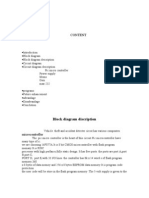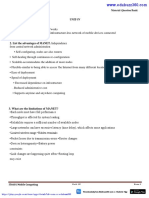Rapid28i™ PIC Prototyping PCB User Manual
Rapid28i™ PIC Prototyping PCB User Manual
Uploaded by
Paul WrightCopyright:
Available Formats
Rapid28i™ PIC Prototyping PCB User Manual
Rapid28i™ PIC Prototyping PCB User Manual
Uploaded by
Paul WrightOriginal Description:
Original Title
Copyright
Available Formats
Share this document
Did you find this document useful?
Is this content inappropriate?
Copyright:
Available Formats
Rapid28i™ PIC Prototyping PCB User Manual
Rapid28i™ PIC Prototyping PCB User Manual
Uploaded by
Paul WrightCopyright:
Available Formats
Rapid28i PIC Prototyping PCB User Manual
Copyright 2004 DH MicroSystems, Inc.
All trademarks mentioned in this document are the property of their respective companies.
Rapid28i PIC Prototyping PCB User Manual Description
This is a PCB designed to facilitate the rapid prototyping of a device based on a 28 pin Microchip PIC microcontroller. To allow users to focus on their application, we take care of key housekeeping tasks associated with a microcontroller-based device. To this end, our PCB features several power supply options, a 28 pin footprint for the microcontroller, and several oscillator options. This board also supports in-circuit programming with a dedicated ICSP header. Users can construct their application circuit in our generous a generous prototyping area with space available for several ICs and /or numerous discrete components. To further simplify the construction of prototype PIC devices, on the end of the PCB opposite from the microcontroller and power supply we have provided several common I/O components. There are 3 push buttons, 3 LEDs, and a buzzer that can be configured for use with the prototype application. This board is constructed as a 2-layer throughhole board with clearly marked components on its silkscreen layer, and ample space between components so population of the board can be done by anyone with basic soldering skills.
Features
General:
Overall board dimensions 3.00 x 3.25. PCB is a 2-layer board with solder masks on both sides and a silk screen graphic. 26 x 13 pin prototyping area (338 pins total). Power and GND bus lines run the length of the prototyping area on both sides (not included in proto total pin count). All 22 microcontroller port pins and ~MCLR pin brought out to a clearly labeled strip along the top of the prototyping area. ICSP header. 4 corner mounting holes. Compatible with all MicroChip PIC 28 pin DIP packaged microprocessors. PIC16C62, 63, 642, 66, 72, 73, 745, 76, 773, PIC16F72, 73, 76, 870, 872, 873, 876, PIC18C242, 252, PIC18F242, 252, 248, 258 (and perhaps others). Crystal or ceramic resonator with external capacitors (DC-20MHz). Ceramic resonator with internal capacitors (DC20MHz). RC oscillator. Footprints provided for either TO-92 or TO-220 voltage regulators. Footprint provided for DC power receptacle. Power-on LED. 3 push buttons. 3 LEDs. Piezo buzzer.
Microprocessor:
Oscillator Options:
Additional Resources
Numerous sources of information are available for both beginning and advanced users. Microchip Technology Inc. manufactures the PIC microcontroller line. Their website can be found at www.microchip.com. It contains datasheets for all of their microcontrollers, app-notes, and code samples for a variety of applications. Another excellent on-line resource for Microchip PIC development is the Piclist at www.piclist.com. It contains project info, code examples, and links to PIC related sites. Beginner users might also consider the books published by Square 1 Electronics. They can be found at www.sq-1.com. This list is by no means comprehensive. Many other excellent websites and publications are available and this list is only intended as a starting point for the beginner.
Power Supply Options:
User I/O Options:
Requirements
In order to assemble and use this board, a user needs to have basic electronic tools and some skill in their usage, and a 28 pin PIC microcontroller and the tools required to write code and program the executable file onto the controller. Additionally, if this board was purchased as a bare PCB, then a number of discrete components are also required to stock it.
Copyright 2004 DH MicroSystems, Inc.
All trademarks mentioned in this document are the property of their respective companies.
Rapid28i PIC Prototyping PCB User Manual Board Schematic
Construction
Partlist:
If you purchased this as a kit, then it included the following components: Printed circuit board IC1-28 pin socket X1-4MHz ceramic resonator VREG1-78L05 voltage regulator (TO-92) DC power receptacle JU1-ICSP header JU2-Jumper block with shorting jumper C1-47uF electrolytic capacitor C2, C4, C5, and C8-0.1uF capacitors R1-470 Ohm, 1/8W, resistor R3-10k Ohm, 1/8W, resistor D1-Green LED D2-1N4148 diode If it was purchased as a kit including parts to complete the user I/O circuitry then it also included: SW1, SW2, & SW3-tactile push-button switches LED1, LED2, & LED3-red and yellow LEDs BUZZ-5V piezo buzzer Q1-2N2222 (TO-92) NPN transistor R4, R8, R9 & R10-10k Ohm, 1/8W, resistors R5, R6, & R7-470 Ohm, 1/8W, resistors Note: parts are not provided to fill all PCB footprints. The user should stock the board appropriately according to the requirements of any particular design (see construction options discussed on the next page).
Copyright 2004 DH MicroSystems, Inc.
All trademarks mentioned in this document are the property of their respective companies.
Rapid28i PIC Prototyping PCB User Manual Construction (Cont.)
Microcontroller Options:
This board will support any 28 pin DIP packaged Microchip PIC microcontroller. The pin descriptions depicted in the schematic on the previous page and on our PCBs represent only basic port definitions for each pin. Refer to the Microchip datasheet for all the features and alternate pin definitions for the microcontroller that you select for use. R3, C8, and D2 are attached to the ~MCLR pin (D2 is added for ICSP compatibility). These components can be omitted and a new reset circuit can be constructed in the prototyping area per instructions found in the Microchip datasheet for your microcontroller. Select these components per instructions found in Microchip datasheets for the microcontroller that you select for use.
Power Supply Options:
This board will support several different voltage regulators in both TO-92 and TO-220 packages (kits ship with a TO-92 78L05) Note: install only one voltage regulator when assembling your board. Keep in mind the current requirements of your circuitry plus the microcontroller when you are selecting an appropriate voltage regulator. Depending on the requirements for the regulator you select, C1, C2, C3, and C4 may or may not be required and their values will vary. Refer to the manufacturers datasheet for your regulator you select for recommendations. A wall adapter can provide power when the DC power receptacle is installed. A 2.1mm ID, 5MM OD DC power plug with a positive center conductor is required. A bench supply can also be used; in this case omit the power receptacle and solder in red and black wires to the pins labeled Vin and GND respectively. Voltage should be 7.5-12VDC. A power-on LED may be installed by stocking R1 and D1 (a green LED).
ICSP:
Note: refer to Microchip datasheets and appnotes for information on the isolation of ICSP related pins. ICSP signals are available on JU1 (refer to the schematic for pin signal assignments). JU2 isolates the PIC from the boards power supply; it should be disconnected when the prototyping board is attached to an ICSP programmer. This jumper eliminates the possibility of excessive loading of the ICSP programmer by other board components or by the users application circuitry. Re-jumper JU2 when the ICSP programmer is disconnected and the board is to be powered via the onboard power supply. If you are not planning on using an ICSP programmer JU1 can be omitted, JU2 can just be permanently shorted with a bit of component lead, and D2 can be replaced with another bit of component lead.
Assembly:
Stock parts in their appropriate locations, paying attention to proper component alignment. Solder components to the PCB with a low wattage soldering iron. Lastly, trim off excess leads and clean off flux residue (if required) with an appropriate solvent. Construct your own circuitry in the open prototyping area. Microcontroller pins are accessed through the labeled strip of pins at the top of the proto area; I/O components are accessed through the labeled pins at the bottom. 5V and GND for your circuit is available on both left and right sides of the proto area in labeled strips.
Oscillator Options:
Several oscillator options are available with this board: ceramic resonator, crystal oscillator, and RC oscillator (kits ship with a 4MHZ ceramic resonator). Pertinent oscillator parts are R2, C6, C7, and X1.
Copyright 2004 DH MicroSystems, Inc.
All trademarks mentioned in this document are the property of their respective companies.
Rapid28i PIC Prototyping PCB User Manual Notes
Contact Us
We maintain a website where you can get information on our products, obtain literature, and download support files. Visit us online at: For sales questions or to place an order, direct your emails to sales@dhmicro.com. Refer to the order form and price list available on our website for product pricing, shipping rates, payment instructions, and for other info we need to complete your order. Our mailing address: DH MicroSystems, Inc. P.O. Box 2272 Pocatello, ID 83206-2272
www.dhmicro.com
Email your technical support questions to support@dhmicro.com. We try to respond to your questions within an hour if it is received Monday through Friday between the hours of 8am to 5pm (Mountain Time).
Disclaimer: DH MicroSystems, Inc. reserves the right to modify its products or literature, or to discontinue any product at any time without prior notice. The customer is responsible for determining the suitability of any device for any application developed using DH MicroSystems, Inc. components.
Copyright 2004 DH MicroSystems, Inc.
All trademarks mentioned in this document are the property of their respective companies.
You might also like
- Transmission Line Multiple Fault Detection and Indication To Electricity BoardDocument74 pagesTransmission Line Multiple Fault Detection and Indication To Electricity BoardCrisp100% (1)
- Implementing SCD 2 With MD5Document6 pagesImplementing SCD 2 With MD5abhishekkr293100% (1)
- SnatchBot Chatbots Everything You Need To Know To Create Your OwnDocument110 pagesSnatchBot Chatbots Everything You Need To Know To Create Your OwnAmitGuptaNo ratings yet
- Basic PIC 40 Development BoardDocument8 pagesBasic PIC 40 Development BoardBasit Ahmad100% (3)
- PIC16F877 Microcontroller TutorialDocument37 pagesPIC16F877 Microcontroller Tutorialmc_prayer100% (4)
- PIC Programming Module USB and Traffic Light System ControllerDocument26 pagesPIC Programming Module USB and Traffic Light System ControllerJosh, LRT100% (1)
- PIC With LCD and ICSP Programmer Board - v3 - JRMDocument7 pagesPIC With LCD and ICSP Programmer Board - v3 - JRMm_menaka100% (2)
- Our Development Board: Product DetailsDocument4 pagesOur Development Board: Product DetailsNabilNo ratings yet
- 8 Channel PWM LED ChaserDocument11 pages8 Channel PWM LED Chaserkagemaruokami100% (1)
- So Do Chan ICDocument305 pagesSo Do Chan ICManh NguyenvanNo ratings yet
- Elesof: Dc-MotorDocument44 pagesElesof: Dc-Motorabhay2703100% (3)
- Atmega32 Dev Board - EFY March11 PDFDocument7 pagesAtmega32 Dev Board - EFY March11 PDFsagar_gy100% (1)
- Tic-Tac-Toe With Mtouch: June 2010Document13 pagesTic-Tac-Toe With Mtouch: June 2010Gabriel LojaNo ratings yet
- MicroPIC18F Lite User ManualDocument19 pagesMicroPIC18F Lite User ManualElena Gilbert100% (1)
- EEEE2046 Electronics Project Week4 LabsheetDocument8 pagesEEEE2046 Electronics Project Week4 Labsheetlaraishaq12345No ratings yet
- Dept. of Electronics: Web ServerDocument50 pagesDept. of Electronics: Web ServerMadhuKumar Nh100% (2)
- IntroductionDocument23 pagesIntroductionArryshah Dahmia100% (4)
- PIC16CXX Microcontroller: Order Code Device Max Freq. Prom RAM I/O Lines Other Features PackageDocument6 pagesPIC16CXX Microcontroller: Order Code Device Max Freq. Prom RAM I/O Lines Other Features PackageMANASANo ratings yet
- Mechatronics Demonstration KitDocument2 pagesMechatronics Demonstration KitZafar HussainNo ratings yet
- HP488 30 3Document25 pagesHP488 30 3Sameh Philipp100% (1)
- Practical PIC ProjectsDocument14 pagesPractical PIC ProjectsArdhika Dhennis Putra Ananda100% (1)
- Easypic2 ManualDocument17 pagesEasypic2 Manualadresa33No ratings yet
- LED ChaserDocument7 pagesLED ChaserMegan Skinner100% (2)
- Devloper BoardDocument82 pagesDevloper Boardpukhraj titreNo ratings yet
- Dspic33F/Pic24H Flash Programming SpecificationDocument84 pagesDspic33F/Pic24H Flash Programming SpecificationSobhi MahNo ratings yet
- EasyDspic4 ManualDocument30 pagesEasyDspic4 ManualPaul Vintimilla TapiaNo ratings yet
- Mpi Final Report V FinalDocument16 pagesMpi Final Report V FinalAsim AslamNo ratings yet
- Pic 16 C 505Document85 pagesPic 16 C 505Joel LopezNo ratings yet
- Evaluation Board s08dz60Document2 pagesEvaluation Board s08dz60Warren O LeddaNo ratings yet
- Users Manual Snadpic100 Rev1.00Document18 pagesUsers Manual Snadpic100 Rev1.00drsvastaNo ratings yet
- PIC12C509ADocument113 pagesPIC12C509AsandrorrrNo ratings yet
- Micro Board Rev 5Document50 pagesMicro Board Rev 5Arman100% (1)
- ControllersDocument21 pagesControllersBrindha 2004No ratings yet
- Section 28. In-Circuit Serial Programming™ (ICSP™) : HighlightsDocument14 pagesSection 28. In-Circuit Serial Programming™ (ICSP™) : HighlightsAnonymous XS9jAhY1pENo ratings yet
- Rds P32mcuDocument3 pagesRds P32mcupablomendivilNo ratings yet
- Pci2Pmc: Dynamic EngineeringDocument15 pagesPci2Pmc: Dynamic EngineeringSteven YangNo ratings yet
- LPC2148Document45 pagesLPC2148communicationNo ratings yet
- Content: Block Diagram DiscriptionDocument31 pagesContent: Block Diagram DiscriptionSriram KrishnanNo ratings yet
- Temperature Control System Using LM35: FeaturesDocument9 pagesTemperature Control System Using LM35: Featuresደመር ወድባርተ ቃንጪNo ratings yet
- PIC LAB ManualDocument13 pagesPIC LAB ManualxyzzyzNo ratings yet
- Pic ReportDocument46 pagesPic ReportknlkohliNo ratings yet
- Ec6711 Emb Lab PDFDocument92 pagesEc6711 Emb Lab PDFAnonymous LXQnmsD100% (1)
- MLK-II Hard WareDocument136 pagesMLK-II Hard Wareashishcnair100% (1)
- Pic-Pg4D Easy Start Pic16F84/Pic16F628 Microcontroller Development BoardDocument3 pagesPic-Pg4D Easy Start Pic16F84/Pic16F628 Microcontroller Development BoardΠΑΝΑΓΙΩΤΗΣΠΑΝΑΓΟΣNo ratings yet
- PIC Millennium Board Farnell Order Code 120-030Document1 pagePIC Millennium Board Farnell Order Code 120-030Hugo OliveiraNo ratings yet
- User's Manual Pic32 Start KitDocument36 pagesUser's Manual Pic32 Start Kitlxz5101100% (1)
- Digital Energy MeterDocument3 pagesDigital Energy MeterbapoonprdNo ratings yet
- Elektor 18F452 Developpement BoardDocument7 pagesElektor 18F452 Developpement BoardAbderrazek YACOUBI100% (2)
- 16c72a PDFDocument121 pages16c72a PDFeliojoseortizNo ratings yet
- Microsquirt-Module Developers Guide-3.4Document17 pagesMicrosquirt-Module Developers Guide-3.4Pedro Felipe Alves de OliveiraNo ratings yet
- 16F723ADocument286 pages16F723ApexeaiNo ratings yet
- Clicker 2 Pic32mx Manual v102Document33 pagesClicker 2 Pic32mx Manual v102yohiliNo ratings yet
- chipKIT Uno32 RevC - RM PDFDocument17 pageschipKIT Uno32 RevC - RM PDFJairo Miguel Vergara Avila100% (1)
- JDM ExtremeDocument4 pagesJDM Extremegenio@3161No ratings yet
- CANBus Logger Final ADocument32 pagesCANBus Logger Final AJatin ChotaliyaNo ratings yet
- 12C509Document85 pages12C509Choco MalaNo ratings yet
- PLC: Programmable Logic Controller – Arktika.: EXPERIMENTAL PRODUCT BASED ON CPLD.From EverandPLC: Programmable Logic Controller – Arktika.: EXPERIMENTAL PRODUCT BASED ON CPLD.No ratings yet
- Programming Arduino Projects with the PIC Microcontroller: A Line-by-Line Code Analysis and Complete Reference Guide for Embedded Programming in CFrom EverandProgramming Arduino Projects with the PIC Microcontroller: A Line-by-Line Code Analysis and Complete Reference Guide for Embedded Programming in CNo ratings yet
- Intermediate C Programming for the PIC Microcontroller: Simplifying Embedded ProgrammingFrom EverandIntermediate C Programming for the PIC Microcontroller: Simplifying Embedded ProgrammingNo ratings yet
- C Programming for the PIC Microcontroller: Demystify Coding with Embedded ProgrammingFrom EverandC Programming for the PIC Microcontroller: Demystify Coding with Embedded ProgrammingNo ratings yet
- Making PIC Microcontroller Instruments and ControllersFrom EverandMaking PIC Microcontroller Instruments and ControllersNo ratings yet
- Textbook Cyber Threat Intelligence Ali Dehghantanha Ebook All Chapter PDFDocument53 pagesTextbook Cyber Threat Intelligence Ali Dehghantanha Ebook All Chapter PDFanthony.moses252100% (18)
- AI Tech TalkDocument48 pagesAI Tech TalkNoman IslamNo ratings yet
- KVMRT SSP Elevated & Systems WCT Holdings Berhad Search Export To Excel Project: KVMRT SSP Elevated & SystemsDocument2 pagesKVMRT SSP Elevated & Systems WCT Holdings Berhad Search Export To Excel Project: KVMRT SSP Elevated & Systemsblackflag1No ratings yet
- How To Set Mongodb To A Different Replica (Backup) Server?: ProductsDocument2 pagesHow To Set Mongodb To A Different Replica (Backup) Server?: ProductsKudakwashe MlalaziNo ratings yet
- BlueDMX Instrukcja v1.0Document2 pagesBlueDMX Instrukcja v1.0skarkopNo ratings yet
- LDOM Guest Domain Cloning Using DDDocument3 pagesLDOM Guest Domain Cloning Using DDgeekyS100% (2)
- Inplant Training ReportDocument7 pagesInplant Training ReportGuruprasad S HegdeNo ratings yet
- Q Corresponding Ethernet Interface Module User's Manual (Basic)Document448 pagesQ Corresponding Ethernet Interface Module User's Manual (Basic)Muhammad Purbo SantosoNo ratings yet
- Telecom Field Engineer Resume SampleDocument20 pagesTelecom Field Engineer Resume SampleDatius JacksonNo ratings yet
- Chap 4Document21 pagesChap 4Suvo IslamNo ratings yet
- Capstone Project FinalDocument34 pagesCapstone Project FinalCymon DazNo ratings yet
- Ict Paper 2Document9 pagesIct Paper 2DennisNo ratings yet
- White Paper Elastic GDPR Compliance and The Elastic StackDocument13 pagesWhite Paper Elastic GDPR Compliance and The Elastic StackPragith PrakashNo ratings yet
- Vivado 2015.2 Tutorial: How To Display Internal Logic Elements in The Simulation WaveformDocument4 pagesVivado 2015.2 Tutorial: How To Display Internal Logic Elements in The Simulation WaveformYarkin ErginNo ratings yet
- MT7986 Power Percentage User Guide For CustomerDocument7 pagesMT7986 Power Percentage User Guide For Customerm34j40r0jNo ratings yet
- Oxo Connect c25 Solution Sheet enDocument2 pagesOxo Connect c25 Solution Sheet enAsnake TegenawNo ratings yet
- 1.define MANET.: 2. List The Advantages of MANET. IndependenceDocument4 pages1.define MANET.: 2. List The Advantages of MANET. IndependenceRAJESHNo ratings yet
- Introduction To Microcontrollers: Department of EIE / Pondicherry Engineering CollegeDocument12 pagesIntroduction To Microcontrollers: Department of EIE / Pondicherry Engineering Collegeprof_kt100% (1)
- Quick Install GuideDocument24 pagesQuick Install GuideAgung W MunandarNo ratings yet
- Yii-Guide-1 1 13Document269 pagesYii-Guide-1 1 13Yender BoyerNo ratings yet
- Uber Request Data - CSV - 1Document196 pagesUber Request Data - CSV - 1divyanshuNo ratings yet
- How To Install Nemo File Manager in UbuntuDocument4 pagesHow To Install Nemo File Manager in UbuntuBobapatatasNo ratings yet
- Linux BazaDocument32 pagesLinux BazaMerei MuratovNo ratings yet
- Assignment 316Document8 pagesAssignment 316vishal kumarNo ratings yet
- Unidirectional Link Detection (UdldDocument2 pagesUnidirectional Link Detection (Udldziad Al-showaiterNo ratings yet
- EESM 5539 Wireless Communications Networks - Table of ContentDocument8 pagesEESM 5539 Wireless Communications Networks - Table of ContentZIQIN PINo ratings yet
- Question Text: Clear My ChoiceDocument5 pagesQuestion Text: Clear My ChoiceKimberly Mae HernandezNo ratings yet
- Imessage: How To Quote A Message in Chat RoomDocument54 pagesImessage: How To Quote A Message in Chat RoomyyNo ratings yet

























































































